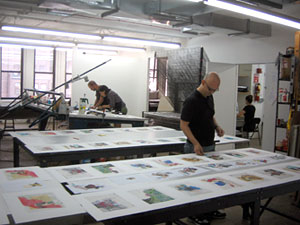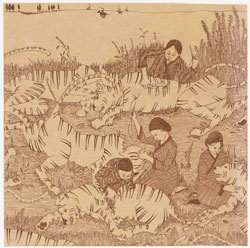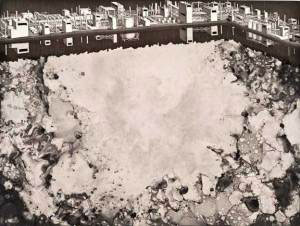Lower East Side Printshop: Working Side by Side with the Artist Community
 Arturo Herrera working on his collages with printers James Miller and Aurora De Armendi assisting, August 2010.
Arturo Herrera working on his collages with printers James Miller and Aurora De Armendi assisting, August 2010. Photograph courtesy of the Lower East Side Print Shop
Since 1968, the Lower East Side Printshop has not only been making art, but making artists. This New York City institution has become a creative Zeitgeist for emerging artists, and the artistic community that's evolved around the New York City printmaking scene.
"Our primary mission is to enable artists to make new work," says executive director Dusica Kirjakovic. "And we work with artists who don't have any experience. They have 24/7 access to our fully equipped studios, and have free studio use with master printers on staff." That was the artistic and community-bound vision of founder/artist/educator Eleanor Magid, who established the nonprofit Lower East Side as a groundbreaking open access art and community center.
Originally based in the East Village, the facility moved in 2005 to a site in Midtown Manhattan five times its original size. Today, with its expansion into more public programming, exhibitions, open studios and educational opportunities, it's the largest openly accessible printmaking facility in New York City and the largest print workspace in the United States.
Each and every year, more than 160 artists benefit from Lower East Side's workspace residency programs, in which recipient artists earn space and time to work, stipends, technical assistance, career development and public exposure.
 Amy Cutler. Tiger Mending, 2003. Etching and aquatint in sepia with chine collé.
Amy Cutler. Tiger Mending, 2003. Etching and aquatint in sepia with chine collé. Photograph courtesy of the Lower East Side Print Shop
"Something that's always been steady over the years is the need for yearlong financial assistance," says Kirjakovic. "That never changes, and neither does our support of 160 artists each year. Lately we're noticing, since the economic crisis began in 2008, that artists have lost gallery support; artists are working part-time jobs, and working on their craft in here more often. Which is kind of liberating for artists, because they have nothing to lose to explore other avenues of styles of art. They don't depend on a gallery for that; they create more for exhibitions."
Kirjakovic knows the Printshop inside and out. The Yugoslavian started out in 1992 as an artist looking for studio time as a printmaker, went on to volunteer in trade for free studio time, was then asked to teach and, when the current director had left, she stepped in and it's where she stands today.
"It's so important to have someone in this position who understands the artists' needs," she says.
Another artist now on the Printshop board is Dread Scott, who began his relationship with the Printshop in 2000. Today, he's renowned for his many art media - from photography to performance - that encompasses the message "Revolutionary Art - Propelling History Forward."
"The common thread in my work is encouraging viewers to confront the world the way it is and how it could be better," he says.The Printshop, he says, has helped him make fantastic work that he wouldn't have been able to make otherwise.
"When I first started, I was on a special editions scholarship and had never done any printmaking," says Scott. "When there was one print that hadn't turned out and was destroyed, one type of screenprinting that was particular to the weather, they had gone on to redo it. That's what proved to me that they're a great advocate for artists - a place that really cares about what is being produced when they didn't have to do that."
 President Jackie Battenfield and executive directorDusica Kirjakovic.
President Jackie Battenfield and executive directorDusica Kirjakovic. Photograph courtesy of the Lower East Side Print Shop
Today, Scott's work has been sold, collected and displayed at high profile spots like the Whitney Museum, published by Fourth Estate and will appear in a show in March at San Jose State University.
"You know, New York is in a difficult place," says Scott. "There are a lot of visual artists working in a lot of media, but we can't afford studio space. This is a very respected place. And I wouldn't be able to work part time without it. Part of the irony is that, up until eight years ago, printmaking was like the 'gutter artform." Printmaking isn't a real painting, it's a print. But the Printshop has changed with the times.
The fine art of printmaking, producing multiple originals of artwork from a copper surface, is worlds away from making prints. The Printshop offers "Intro to Printmaking," an eight-week overview on intaglio techniques, including etching, carved blocks, creating plats and printing multiple color plates with Akua Water-based inks.
"Artists are really experimenting with this type of water-based, non-toxic ink for copper plate printing because it's so much easier to work with," says Kirjakovic. "And we encourage that."
Kirjakovic's admiration for copper is another facet in her career that has remain unchanged.
"The aqua tint that one can work in with copper is unbelievable," she says. "It's the best metal because it consists of so many smaller particles. It's really soft so you can create a wide range of marks; but it's also a tough metal. You can maybe get 10 to 20 prints from copper and it withstands it."
The Printshop's master printer James Miller and assistants work by hand with artists and publishers on contract printing projects, including services like platemaking and editioning - for both new and seasoned printmakers.
 Michael Schall. The Accident (2008). Aquatint, etching, monoprint, and screenprint. Edition of 12.
Michael Schall. The Accident (2008). Aquatint, etching, monoprint, and screenprint. Edition of 12. Photograph courtesy of the Lower East Side Print Shop
Studio rental on an hourly, daily, weekly and monthly basis is available to those who have some experience under their belt (no assistance is offered in this program). The Printshop also offers several residency programs for emerging artists to develop their work, including a year-long Keyholder Residency Program. Participants receive a $1,000 stipend, use of a shared artists' studio and the chance to experiment with intaglio, relief, monoprint, water-based silkscreen techniques, photo and digital processes and other techniques, and access to a solvent/etching area and onsite darkroom. A rotating committee evaluates each application; residencies are supported by grants from the New York State Council on the Arts, Jerome Foundation, NYC Department of Cultural Affairs, New York Community Trust, Akua Water-based Inks and more.
The Special Editions Residency (up to $4,000 stipend) is a national program for emerging artists in printmaking; each artist completes a new work in collaboration with one master printer. Several Publishing Residencies are also awarded each year.
Successful artists who began their career at the Printshop in the studio or in one of these programs include Kiki Smith, Nancy Spero and Leon Golub, Philip Taaffe, Robert Longo, Bullet Space and others. Recent artist collaborations include those with Ghada Amer, Sebastiaan Bremer, Zana Briski and Paul Chan.
But Kirjakovic wants to emphasize that the Printshop welcomes artists in all stages of their career, or just members of the public who are interested in taking their first class.
"Everyone is welcome here, whether it's for a show, or to take a peek at one of our education programs," she says. "You can even buy studio time for someone in a gift certificate."
The Lower East Side Printshop is one of the founding members of the New York State Artist Workspace Consortium. In 2006, it was awarded the Primary Organization status by the NY State Council on the Arts.
Resources:
Also in this Issue:
- Lower East Side Printshop: Working Side by Side with the Artist Community
- Evan Summer: The Fine Art of Intaglio
- Quincy Pond Print Works: Past Lives Brought into Focus
- New Show at Washington Printmakers Gallery Features Work by the New York Society of Etchers
- This History of Intaglio
